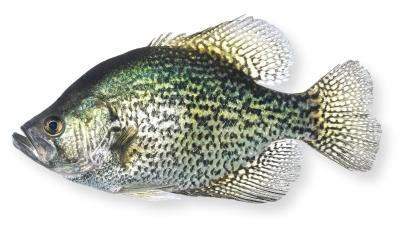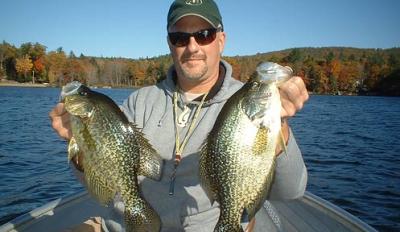Black Crappie
Pomoxis nigromaculatus
 Distribution: This non-native species is distributed throughout New Hampshire. Surveys performed by the New Hampshire Fish and Game Department in 1938 reported that the first black crappie populations in New Hampshire were found in Horseshoe Pond (Merrimack) and in the Merrimack River(Nashua). The New Hampshire Fish and Game Department stocked black crappie into 20 waterbodiesfrom 1990 through 2002. There are now over 100 waterbodies in the state that have black crappie populations due to illegal fish transfers. The native range of black crappie includes the Mississippi River, Great Lakes, and Atlantic coastal watersheds south of Maryland.
Distribution: This non-native species is distributed throughout New Hampshire. Surveys performed by the New Hampshire Fish and Game Department in 1938 reported that the first black crappie populations in New Hampshire were found in Horseshoe Pond (Merrimack) and in the Merrimack River(Nashua). The New Hampshire Fish and Game Department stocked black crappie into 20 waterbodiesfrom 1990 through 2002. There are now over 100 waterbodies in the state that have black crappie populations due to illegal fish transfers. The native range of black crappie includes the Mississippi River, Great Lakes, and Atlantic coastal watersheds south of Maryland.
Description: Body is very deep and laterally compressed. Has a large mouth and when it is closed the upper jaw extends past the middle of the eye. There are 7-8 dorsal spines and 5-7 anal spines. Dark olive back with sides yellowish-green to silver and dark mottling.
Species commonly confused with: Rock bass
Habitat: Often found in small schools near cover such as vegetation, fallen trees, or boulders. In the spring,black crappie are found in shallow water, but they tend to roam in deeper water during the summer and fall.
Life History: Black crappie spawn in the spring when water temperatures reach 58° to 64°F. The male sweeps out a circular nest in 3 to 8 feet of water on a mud to sand bottom hidden in vegetation. The female will lay 20,000 to 60,000 eggs. Like other members of the sunfish family the male will guard the nest until the young start to feed. The young will grow 2-3 inches in the first year and are mature by the second or third year. Crappie primarily feed on insects, insect larvae, and small fish.
 Origin: Introduced
Origin: Introduced
Conservation/Management: There are no specific conservation or management objectives for black crappie. They are managed through daily bag limits. In recent years black crappie have become increasingly popular with anglers because they are considered to be good table fare and are now found throughout the state. Please remember that the release of fish in waters other than where they were caught is prohibited. Introduced species can cause unpredictable harm to native species.
Fishing Tips: Black crappie can be caught on a variety of small lures and baits. The most popular lures are small jigs, tubes, and live minnows. During spring and early summer focus in and around vegetation, rocks, and large woody material. In the summer, fall, and winter months focus around the deeper water of the main basin of the lake or pond that you are fishing.



